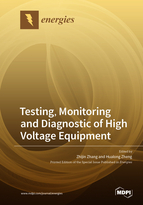Testing, Monitoring and Diagnostic of High Voltage Equipment
A special issue of Energies (ISSN 1996-1073). This special issue belongs to the section "F6: High Voltage".
Deadline for manuscript submissions: closed (21 February 2023) | Viewed by 25572
Special Issue Editors
2. Xuefeng Mountain Energy Equipment Safety National Observation and Research Station of Chongqing University, Chongqing 400044, China
Interests: electrical external insulation for complex environment
Special Issues, Collections and Topics in MDPI journals
Interests: environmental adaptability testing; electromechanical characteristics
Special Issues, Collections and Topics in MDPI journals
Special Issue Information
Dear Colleagues,
Techniques for the transmission of electrical energy have been developed since the first stumbling steps in the late 19th century, leading into today’s sprawling international grid providing electricity in virtually any nook and cranny of the world. Increasing demand has necessitated increase of transmission voltages. Therefore, high voltage equipment has become an increasingly important part of the power system. Testing, monitoring and diagnostic on high voltage equipment (Insulator, transformer, cable, GIS, etc.) are the base of condition maintenance and essential for an economic usage of high voltage equipment.
This Special Issue is aimed at exploring and demonstrating the novel ideas and valuable outcomes addressing the various aspects of testing, monitoring, and diagnostic of high voltage equipment, such as
- On-line monitoring technology
- Partial discharge measurement
- New methods for testing, monitoring, and diagnostic
- Pollution and icing characteristics of insulation equipment
- Insulation deterioration characteristics and diagnosis (Power cable, silicone rubber composite insulator, etc.)
- Electrical breakdown characteristics
- Numerical modeling and simulation
While the above-mentioned list may not cover all the issues related to testing, monitoring, and diagnostics of high voltage equipment, this Special Issue welcomes the submission of manuscripts on other similar topics of interest as well as those that contribute to enhance the knowledge, testing methods, condition monitoring abilities, diagnostic methods, and thus the reliability of the power grids.
Prof. Dr. Zhijin Zhang
Dr. Hualong Zheng
Guest Editors
Manuscript Submission Information
Manuscripts should be submitted online at www.mdpi.com by registering and logging in to this website. Once you are registered, click here to go to the submission form. Manuscripts can be submitted until the deadline. All submissions that pass pre-check are peer-reviewed. Accepted papers will be published continuously in the journal (as soon as accepted) and will be listed together on the special issue website. Research articles, review articles as well as short communications are invited. For planned papers, a title and short abstract (about 100 words) can be sent to the Editorial Office for announcement on this website.
Submitted manuscripts should not have been published previously, nor be under consideration for publication elsewhere (except conference proceedings papers). All manuscripts are thoroughly refereed through a single-blind peer-review process. A guide for authors and other relevant information for submission of manuscripts is available on the Instructions for Authors page. Energies is an international peer-reviewed open access semimonthly journal published by MDPI.
Please visit the Instructions for Authors page before submitting a manuscript. The Article Processing Charge (APC) for publication in this open access journal is 2600 CHF (Swiss Francs). Submitted papers should be well formatted and use good English. Authors may use MDPI's English editing service prior to publication or during author revisions.
Keywords
- high-voltage tests
- measurement techniques
- novel measurement devices
- high voltage operation
- electrical insulation
- condition monitoring
- insulation Breakdown
- partial discharge
- aging performance







